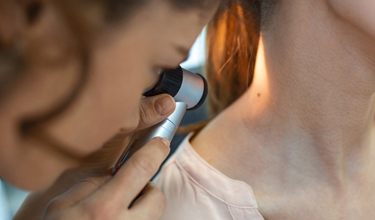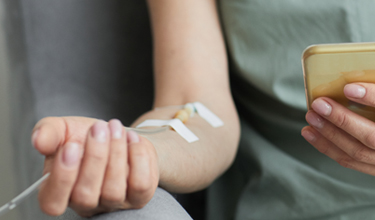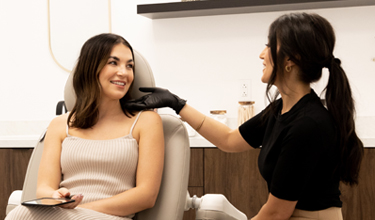Mohs Micrographic Surgery
What is Mohs skin cancer surgery?
Mohs micrographic surgery is a specialized outpatient surgical procedure to remove skin cancers in functionally and aesthetically sensitive areas. Mohs is the gold standard treatment for skin cancers including basal and squamous cell skin cancer lesions on the face, scalp, ears, hands, shins, feet and genitals. Depending on the size of a lesion, Mohs surgery can also also be performed on other areas. Mohs surgery offers the highest cure rates and best cosmetic results for skin cancers in cosmetically sensitive areas, where standard excision could be disfiguring.
Melanoma is the most dangerous type of skin cancer. When caught early, Dr. Sheila Farhang, a fellowship trained Mohs micrographic surgeon, will perform the procedure on melanoma in situ (localized melanoma), when the cancer is only in the outermost layer of skin, and has not spread. Dr. Farhang expertly performs Mohs microsurgery on these other more rare skin cancers including sebaceous carcinoma, Atypical fibroxanthomas, and dermatofibroscaroma protuberans.
Mohs surgery is the least invasive and most effective treatment for nonmelanoma and melanoma skin cancers. Reported five – year cure rates are 98% or greater for common nonmelanoma skin cancers.
The high success rate is due to the fact that the surgeon functions as a surgeon and a pathologist. Dr. Sheila Farhang excises the cancerous tissue layer by layer and views each layer of tissue under the microscope while the patient waits, until finally no cancer cells can be found. This eliminates the situation where the tumor was excised, the wound closed, and the tissue sent to a pathologist for examination, only to discover that tumor cells still exist, thereby necessitating a second surgery.
The history of Mohs surgery
Dr. Frederic Mohs developed Mohs micrographic surgery in the 1930s and the procedure has since been refined and updated for modern use. Dr. Mohs realized that skin cancer is like the “tip of the iceberg” and that what we see is only the outward manifestation, but that the cancer grows into the skin like the roots of a tree and is only visible with microscopic analysis. Mohs Micrographic surgery reaches and removes the roots of nonmelanoma and melanoma skin cancers.
How is Mohs surgery performed?
Mohs micrographic surgery is a highly specialized and precise procedure performed solely by surgeons with advanced training who are both surgeon and pathologist. It is an outpatient procedure performed under local anesthetic in our Tucson Arizona dermatology practice.
The area to be treated is numbed with local anesthetic and the lesion is removed one layer at a time. Each layer is then prepared with colored dyes and is examined under a microscope to identify and map the microscopic roots of the cancer. The procedure is repeated until no tumor cells can be detected under microscopic examination. The wound is repaired to ensure limited scarring.
However, because Mohs Micrographic is reserved for cosmetically sensitive areas, Dr. Farhang uses her training and expertise in reconstructive and cosmetic surgery to minimize scarring. She will also recommend special steps to assure the best cosmetic outcome. Scars will improve with time. After the surgery you will wear a bandage until the sutures are removed 5-7 days later.
It usually takes about an hour to remove a tissue sample and examine it for cancer cells. While it can take a day to go through all the layers to remove the tumor, this process eliminates the need to overestimate the depth of the tumor and allows for preservation of greatest amount of cancer free healthy tissues. Mohs micrographic surgery offers significantly better cosmetic results than traditional excisional surgery.
The temporary side effects of Mohs micrographic surgery include swelling, bruising, tenderness and tightness at the site while the tissue heals. This is normal and temporary. Risks are the same as with any surgical procedure that does not require general anesthesia.
What are the advantages of Mohs surgery?
- While the procedure takes time, it offers the best cosmetic and functional outcome.
- It ensures that the cancer is completely removed during a single surgery, avoiding a second surgery and the risk of cancer recurrence.
- Mohs surgery preserves the greatest amount of healthy tissue while eliminating the cancerous tissue.
- Repair of the surgical site is accomplished the same day as the Mohs surgery.
- It offers a cure rate of 98% for nonmelanoma skin cancers, and can cure skin cancer even after other methods have failed.
When is Mohs surgery recommended?
This highly technical surgery is usually reserved for certain circumstances, specifically:
- To remove melanoma and nonmelanoma skin cancers, and especially carcinomas that are in a cosmetically sensitive area, near important features and to preserve healthy tissue for the best aesthetic and functional outcome. Cosmetically sensitive areas include the face, nose, lips, eyelids, ears, fingers, toes and genitals.
- When the tumor is large and has indistinct margins.
- When there is a high risk of recurrence.
- To remove a recurrent skin cancer.
- When the tumor is located near scar tissue.
- When the tumor is aggressive and fast growing.
Schedule a Mohs skin cancer surgery consultation
Dr. Sheila Farhang is a board – certified dermatologist in Tucson, Arizona. She is fellowship trained in the highly specialized Mohs micrographic surgical procedure, cutaneous oncology and reconstruction. She has the experience and skills, and state-of-the-art technology to provide the best dermatology care available. If you’re searching for the best dermatologist to diagnose and treat skin cancer, schedule a consultation.
Dr. Sheila Farhang is one of only a few Mohs micrographic surgeons in the Tucson area, and the only one who is also a cosmetic surgeon. Contact our practice Avant Dermatology and Aesthetics in Tucson, Arizona today.







 / 291 Reviews
/ 291 Reviews
socialize with avant
#naturalskin